Microsoft Windows XP Media Center Edition 2005: Feature and Performance Investigation
by Anand Lal Shimpi on October 12, 2004 12:19 PM EST- Posted in
- Smartphones
- Mobile
Watching TV - Media Center gets Shortcuts
Even though it is almost two years old, the original Media Center interface still reigns as the best of the best when it comes to DVRs - set top box or PC based. The interface wasn't perfect at its release, but it was very, very close. Microsoft had done their research and the Media Center interface was quick to navigate and thanks to the power of the PC, was light years faster than any set-top PVR. With MCE2005, Microsoft took a few more steps towards perfection.
One of the biggest changes comes in the introduction of shortcuts; Microsoft has introduced a new second layer of menus referred to as shortcuts that appear as you select options in the first menu layer. Not all options have a second shortcut layer, but the ones that make sense do.
Selecting My TV for example reveals a set of three shortcuts, letting you go directly to Recorded TV, Live TV as well as a link to Movies on TV. While just scrolling to the My TV link will show its shortcuts to the right of it, hitting the right button on the remote will fade in to the shortcut menu to give you direct access to the individual items.
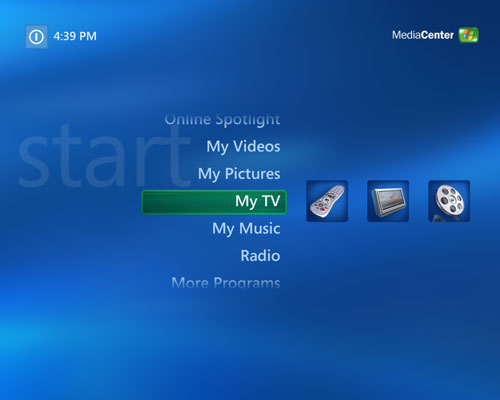
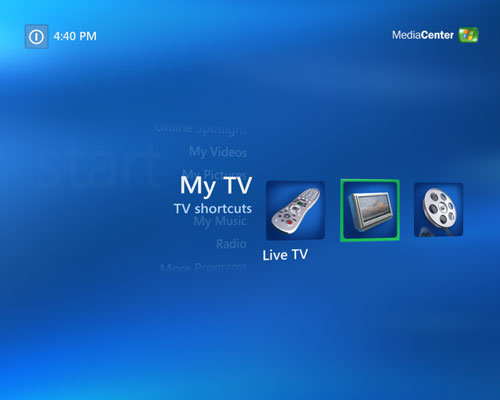
The shortcuts are pretty self explanatory; the Recorded TV link will take you to your recorded shows and live TV will let you watch TV. The Movies link will take you to a pretty neat page of all of the movies that are currently playing on TV; Media Center also pulls data from the All Movie Guide (AMG) to provide movie art, cast information and a movie review for most movies.

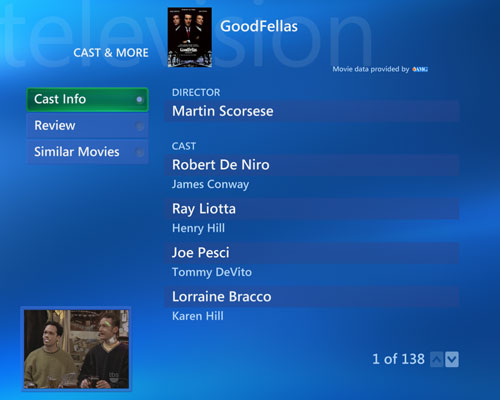

The interface is extremely easy to follow, and if you happen to have a good number of premium or movie channels on your cable lineup then the Movies link ends up being pretty useful. It's like your own Blockbuster where you rent for free. You can also get a listing of upcoming movies, which works very well for selecting what you want to record as well as what you'd like to watch.
Other menu items have shortcuts as well, such as My Music and More Programs, both of which we will get to shortly. Although they are not user definable, the introduction of shortcuts prevents the main Media Center menu from becoming scroll fest when trying to find what you want to do today.
Actually watching TV hasn't changed much. The channel information, volume controls and timescale bar have all received a slightly updated look, but their functionality remains the same.
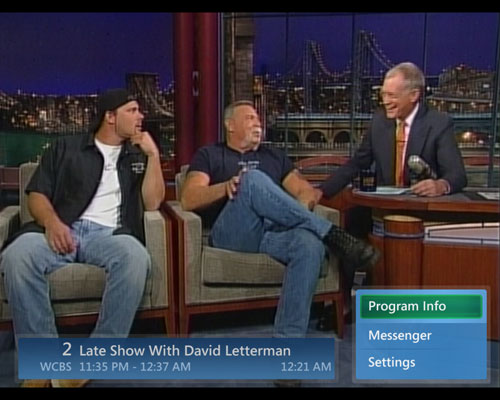
As with all PVR/DVR systems, there is a pause between switching channels as the system must start buffering before changing channels. This buffering time can be minimized with faster hardware, and what we have noticed is that the time between switching channels is indeed faster under MCE 2005 with an Athlon 64 FX-53 than with previous versions of MCE running on slower hardware. The delay is still noticeable, but it is much less dramatic as it used to be the past couple of times we've covered Media Center launches.
Program guide performance has been significantly improved since the original incarnation of MCE; while it used to be true that scrolling through the Guide would sometimes cause your video to stutter or skip, that is no longer true. MCE 2005 does a much better job of prioritizing the video encoding thread above any and all other threads running alongside it, so while your menu may not scroll as smoothly at least your video does - which is far more important.The days of dropped frames due to interacting with the GUI are long gone, even on slower machines as you will see in our performance investigation section.
For those of you that aren't familiar with Media Center's Guide, it is just as navigable as a Tivo or ReplayTV - but much, much faster thanks to the incredible processing power of a modern day x86 PC vs. the low power chips that run most set top boxes.

Maybe it's just that we're testing the Guide on faster hardware than when the original MCE and even MCE 2004 were released, but with MCE 2005 the program guide does appear to get cached much better. After scrolling through the list of channels once there are hardly any swaps to the disk, which wasn't always the case in previous versions of MCE. That being said, any sort of navigation through the GUI is extremely CPU intensive; remember that MCE is still Windows XP, and thus it's primarily a software-accelerated GUI doing some pretty fancy things that our general purpose x86 CPUs weren't necessarily designed to do.
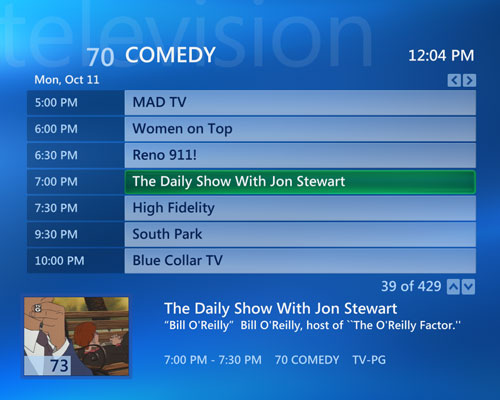
If there ever was a need for a 3D accelerated UI, Media Center would be it - offloading the interface to a GPU would make things run a lot smoother. But let's not get too ahead of ourselves, we shouldn't be wishing for MCE 2007 when we're not even done reviewing 2005.










26 Comments
View All Comments
martydee - Sunday, February 6, 2005 - link
Does anyone know if a PVR card with a hardware DVD DECODER (such as the Hauppauge WinTV-PVR 350) is compatible with Windows MCE? And would a hardware decoder give any real benefits to the system over the software equivilent (i.e. nVidia DVD decoder)?louisb - Thursday, January 13, 2005 - link
mulminute - Wednesday, October 20, 2004 - link
My biggest use is sending music and photos to entertainment center,. Should I use MC 2004 or wait for 2005mulminute - Wednesday, October 20, 2004 - link
My biggest use is sending music and photos to entertainment center,. Should I use MC 2004 or wait for 2005CZroe - Sunday, October 17, 2004 - link
"Windows MCE will never be any use for people serious about video until it allows you to select what codecs you want to use for encoding from all the DirectShow codecs installed on your system. Having to use the proprietary MS stuff with all their DRM garbage is unsuitable."You're clearly one seriously misinformed individual. MCE isn't an interface to multiple video formats and types and simply wonld not function correctly if it were.
Understand this: An MCE PC has one or more TV tuners and video capture cards in it and they will function exactly like any other PC with that hardware. If you want to record in the format of your choice with an XP MCE PC, no one is stopping you. Fire up your application of choice, select your codec and complain to the software maker that they don't have their own integrated EPG and automatic scheduling capabilities. Honestly, how would you expect EVERY format to support embedded CC and on the fly sequence removal? How could you expect hardware encoding support for any directshow enabled codec? You can't just throw a pre-encoded MPEG2 stream from the hardware into any encoder and expect real time results.
glennpratt - Thursday, October 14, 2004 - link
Definately go to www.thegreenbutton.com/community I'm in the US so I don't know much about getting EPG and what not in Australia, but there are a bunch of people from around the world there. The first page load is excruciatingly slow on the site, but once you on its OK.tantryl - Thursday, October 14, 2004 - link
Quick question that again I haven't seen addressed that much. On the Best/Better etc. quailty settings, what is the average MB/hour ratio?How many hours could you store on your average 200GB (191 real GB)?
tantryl - Thursday, October 14, 2004 - link
Thanks glenn.I'm in Australia so TiVo or the like is not currently an option (although I've heard rumours it'll be here within another year). The main problem with it is the program guide.
Australia is officially supported by MCE2005, and I'm very interested in just what that means. So far it looks like no Australia specific music or movie internet services are supported, but I can't find anything to say definately either way. I'm so desperate I'm even considering ringing up Microsoft and going through the quagmire that is customer relations there. But the good thing is, I'm fairly certain (although again, not seen it in writing yet) that the program guide system will work. We only have 5 free-to-air channels and a couple of pay-tv subscription services (that are really the same service packaged differently) so it shouldn't be too hard for them to keep up to date.
Looking at the performance I'm not seeing a hugley compelling reason to go any higher than a Sempron 3100+ although that might be something that would change once I actually get my hands on it and experience it.
Hmmmm. All interesting stuff.
glennpratt - Wednesday, October 13, 2004 - link
jamawass - There is an IR blaster connected to the remote USB reciever. There are two ports on it, but the old remote only came with one blaster, the new one which is actually cheaper then the old one comes with two.http://www.newegg.com/app/ViewProductDesc.asp?desc...
If you have one you'll understand (or a linux based competitor). The flexibility is awesome (just think about it, it's a whole computer. Not only do you have all the flexibilty advanteges of MCE, you have a full blown OS underneath) compared to a Tivo. It's also MUCH MUCH faster then a Tivo.
As for stability, it all depends on the computer you build it on. You can't tell it's a PC if all you have is the remote. Mine has run for nearly a year, nonstop. You can even put it in S3 (Suspend to ram) and it will still wake up and record when it has to, just like Tivo.
Really, HTPC serves a very different market then Tivo. It has a million more uses then Tivo + DVD Recorder.
For me I have an old high end CRT data projector in my living room, and the cheapest thing I could connect to it when I first got it was a computer. Haven't looked back, even as transcoders have gotten much better and cheaper.
jamawass - Wednesday, October 13, 2004 - link
How does mce control digital cable boxes for scheduled recordings? Does the remote have a built in IR blaster?